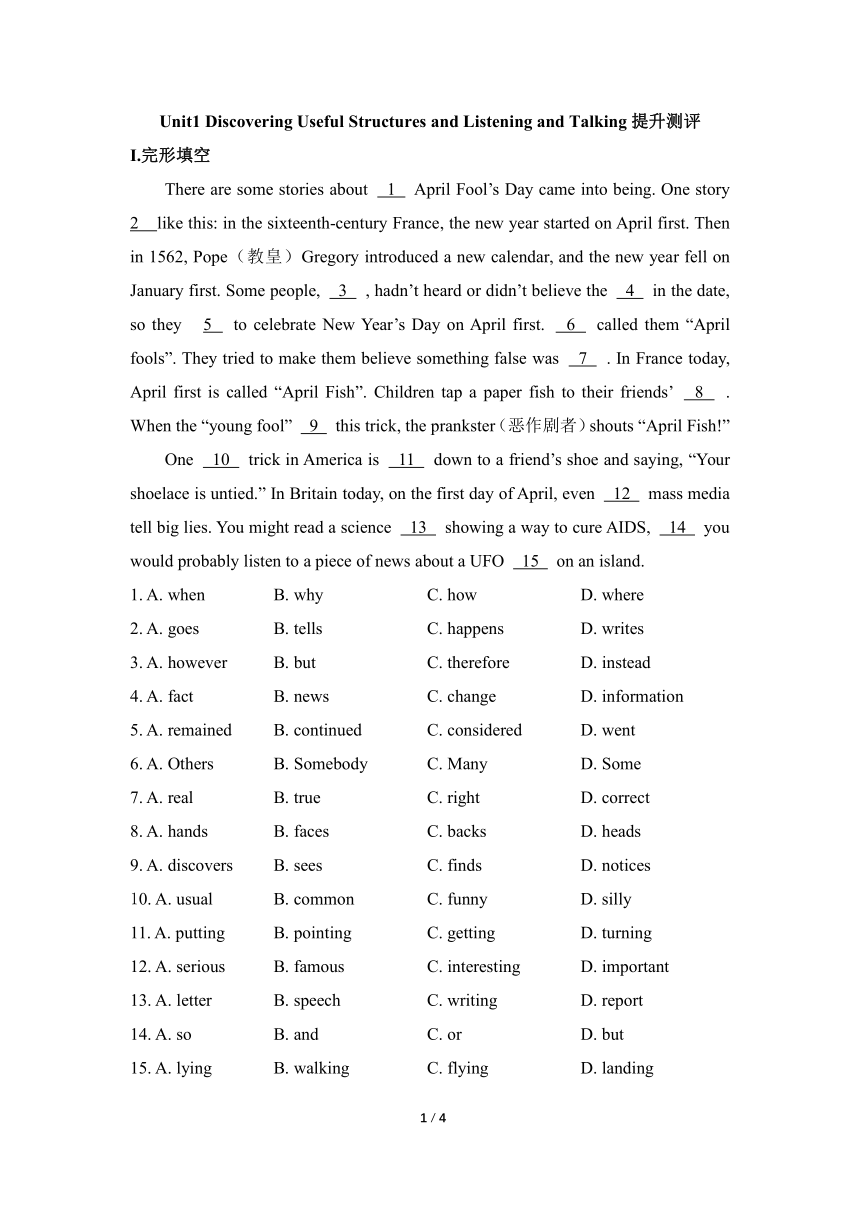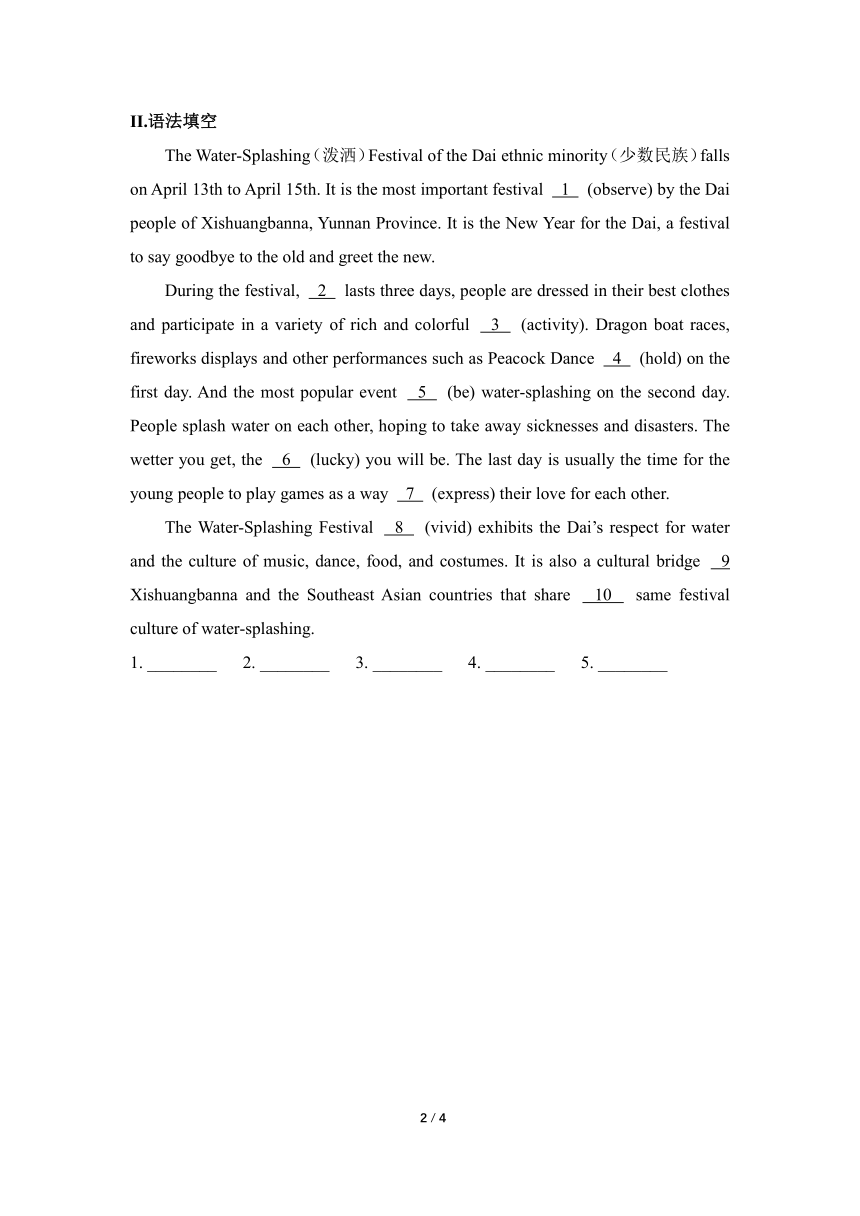人教版(2019)高中英语必修第三册 Unit1 Festivals and Celebrations Structures and Listening and Talking提升测评(有答案)
文档属性
| 名称 | 人教版(2019)高中英语必修第三册 Unit1 Festivals and Celebrations Structures and Listening and Talking提升测评(有答案) |

|
|
| 格式 | docx | ||
| 文件大小 | 18.2KB | ||
| 资源类型 | 教案 | ||
| 版本资源 | 人教版(2019) | ||
| 科目 | 英语 | ||
| 更新时间 | 2023-03-10 13:21:19 | ||
图片预览


文档简介
Unit1 Discovering Useful Structures and Listening and Talking提升测评
Ⅰ.完形填空
There are some stories about 1 April Fool’s Day came into being. One story 2 like this: in the sixteenth-century France, the new year started on April first. Then in 1562, Pope(教皇)Gregory introduced a new calendar, and the new year fell on January first. Some people, 3 , hadn’t heard or didn’t believe the 4 in the date, so they 5 to celebrate New Year’s Day on April first. 6 called them “April fools”. They tried to make them believe something false was 7 . In France today, April first is called “April Fish”. Children tap a paper fish to their friends’ 8 . When the “young fool” 9 this trick, the prankster(恶作剧者)shouts “April Fish!”
One 10 trick in America is 11 down to a friend’s shoe and saying, “Your shoelace is untied.” In Britain today, on the first day of April, even 12 mass media tell big lies. You might read a science 13 showing a way to cure AIDS, 14 you would probably listen to a piece of news about a UFO 15 on an island.
1. A. when B. why C. how D. where
2. A. goes B. tells C. happens D. writes
3. A. however B. but C. therefore D. instead
4. A. fact B. news C. change D. information
5. A. remained B. continued C. considered D. went
6. A. Others B. Somebody C. Many D. Some
7. A. real B. true C. right D. correct
8. A. hands B. faces C. backs D. heads
9. A. discovers B. sees C. finds D. notices
10. A. usual B. common C. funny D. silly
11. A. putting B. pointing C. getting D. turning
12. A. serious B. famous C. interesting D. important
13. A. letter B. speech C. writing D. report
14. A. so B. and C. or D. but
15. A. lying B. walking C. flying D. landing
II.语法填空
The Water-Splashing(泼洒)Festival of the Dai ethnic minority(少数民族)falls on April 13th to April 15th. It is the most important festival 1 (observe) by the Dai people of Xishuangbanna, Yunnan Province. It is the New Year for the Dai, a festival to say goodbye to the old and greet the new.
During the festival, 2 lasts three days, people are dressed in their best clothes and participate in a variety of rich and colorful 3 (activity). Dragon boat races, fireworks displays and other performances such as Peacock Dance 4 (hold) on the first day. And the most popular event 5 (be) water-splashing on the second day. People splash water on each other, hoping to take away sicknesses and disasters. The wetter you get, the 6 (lucky) you will be. The last day is usually the time for the young people to play games as a way 7 (express) their love for each other.
The Water-Splashing Festival 8 (vivid) exhibits the Dai’s respect for water and the culture of music, dance, food, and costumes. It is also a cultural bridge 9 Xishuangbanna and the Southeast Asian countries that share 10 same festival culture of water-splashing.
1. ________ 2. ________ 3. ________ 4. ________ 5. ________
答案:
I.语篇解读:本文是一篇说明文。文章对愚人节的起源做了简单介绍。在世界各地,人们用不同的方式来庆祝这个特殊的节日。
1.C 由后文 One story可知此处是在讲述愚人节的来历,故用how。
2.A One story goes意为“其中一个说法是”。
3.A 由语境可知此处表转折。由空格前后的逗号可确定用 however。
4.C 新年的时间由四月改为一月,这是时间的改变,故用change。
5.B 因为有的人没听说或不相信新年时间的改变,所以会“继续(continued)”在四月一日庆祝新年。
6. A Others与前文的Some相对应。some...others...意为“一些……另一些……”。
7.B 此处指人们试图让别人相信假的事情是“真的”。false的反义词为true。
8.C 由常识可知,只有把纸鱼贴到“背部(backs)”,被捉弄的人才不容易发现。
9.A 被捉弄的人后来会发现人们的把戏。意为“发现”,而find强调“找到”。
10.B 由后文可知,指着别人的鞋子说鞋带没系好是愚人节人们的普遍做法。usual意为“通常的”,而 common可指“常见的,普遍的”。
11.B人们捉弄别人的一种常见做法是“指着”别人的鞋子说鞋带没有系好。point“指着”。
12.A 由空格前的“even”及后文内容可知,此处应用serious,意为“严肃的”。
13.D a science report指“一篇科学报告”。
14.C 此处列举大众传媒在愚人节可能会说的“谎”,or表示可能性,意为“或者”。
15.D 由UFO及空格后的介词on可知此处表示“UFO在个岛上着陆”。land on“在…着陆”。
II.语篇解读:本文是一篇说明文,介绍了傣族泼水节的相关情况,包括时间、活动内容和意义等。
1. observed 句意:它是云南省西双版纳的傣族人所庆祝的最重要的节日。根据该句中的“by the Dai people”可知动词 observe和名词 festival之间是逻辑上的被动关系故用过去分词短语作后置定语。
2. which 分析该句结构可知,设空处引导非限制性定语从句且在从句中作主语,先行词为“the festival”,故用 which引导该定语从句。
3. activities activity意为“(为兴趣、娱乐或达到一定目的而进行的)活动”时常用复数,根据该句中的“a variety f”可知,此处表示“多种多样的活动”,故用其复数形式。
4. are held 该句主语为“Dragon boat races,fireworks displays and other performances such as Peacock Dance故谓语动词用复数形式;主语和动词hod之间为被动关系,故用被动语态。故填 are held。
5. is 该句主语为“the most popular event”,为单数,故谓语动词用单数;由全文的时态可知此处应用一般现在时。
6. luckier 根据句子结构和该句中的“The wetter”可知,该句使用了“The+比较级,the+比较级”结构,表示“越……就越……”。故填 luckier。
7. to express 句意:最后一天通常是年轻人玩游戏的日子以此作为表达他们对彼此的爱的一种方式。way后面接不定式作定语。
8. vividly 句意:泼水节生动地展示了傣族人对水和对音乐、舞蹈、食物以及服饰文化的尊重。设空处修饰exhibits,故用 vivid的副词形式。
9. between 句意:它也是西双版纳和东南亚国家之间的文化桥梁,这些国家分享相同的泼水节文化桥梁,这些国家分享相同的泼水节文化。Between…and...为固定搭配,意为“在……和……之间”。
10. the 考查冠词。the same相同的,一样的。
2 / 2
Ⅰ.完形填空
There are some stories about 1 April Fool’s Day came into being. One story 2 like this: in the sixteenth-century France, the new year started on April first. Then in 1562, Pope(教皇)Gregory introduced a new calendar, and the new year fell on January first. Some people, 3 , hadn’t heard or didn’t believe the 4 in the date, so they 5 to celebrate New Year’s Day on April first. 6 called them “April fools”. They tried to make them believe something false was 7 . In France today, April first is called “April Fish”. Children tap a paper fish to their friends’ 8 . When the “young fool” 9 this trick, the prankster(恶作剧者)shouts “April Fish!”
One 10 trick in America is 11 down to a friend’s shoe and saying, “Your shoelace is untied.” In Britain today, on the first day of April, even 12 mass media tell big lies. You might read a science 13 showing a way to cure AIDS, 14 you would probably listen to a piece of news about a UFO 15 on an island.
1. A. when B. why C. how D. where
2. A. goes B. tells C. happens D. writes
3. A. however B. but C. therefore D. instead
4. A. fact B. news C. change D. information
5. A. remained B. continued C. considered D. went
6. A. Others B. Somebody C. Many D. Some
7. A. real B. true C. right D. correct
8. A. hands B. faces C. backs D. heads
9. A. discovers B. sees C. finds D. notices
10. A. usual B. common C. funny D. silly
11. A. putting B. pointing C. getting D. turning
12. A. serious B. famous C. interesting D. important
13. A. letter B. speech C. writing D. report
14. A. so B. and C. or D. but
15. A. lying B. walking C. flying D. landing
II.语法填空
The Water-Splashing(泼洒)Festival of the Dai ethnic minority(少数民族)falls on April 13th to April 15th. It is the most important festival 1 (observe) by the Dai people of Xishuangbanna, Yunnan Province. It is the New Year for the Dai, a festival to say goodbye to the old and greet the new.
During the festival, 2 lasts three days, people are dressed in their best clothes and participate in a variety of rich and colorful 3 (activity). Dragon boat races, fireworks displays and other performances such as Peacock Dance 4 (hold) on the first day. And the most popular event 5 (be) water-splashing on the second day. People splash water on each other, hoping to take away sicknesses and disasters. The wetter you get, the 6 (lucky) you will be. The last day is usually the time for the young people to play games as a way 7 (express) their love for each other.
The Water-Splashing Festival 8 (vivid) exhibits the Dai’s respect for water and the culture of music, dance, food, and costumes. It is also a cultural bridge 9 Xishuangbanna and the Southeast Asian countries that share 10 same festival culture of water-splashing.
1. ________ 2. ________ 3. ________ 4. ________ 5. ________
答案:
I.语篇解读:本文是一篇说明文。文章对愚人节的起源做了简单介绍。在世界各地,人们用不同的方式来庆祝这个特殊的节日。
1.C 由后文 One story可知此处是在讲述愚人节的来历,故用how。
2.A One story goes意为“其中一个说法是”。
3.A 由语境可知此处表转折。由空格前后的逗号可确定用 however。
4.C 新年的时间由四月改为一月,这是时间的改变,故用change。
5.B 因为有的人没听说或不相信新年时间的改变,所以会“继续(continued)”在四月一日庆祝新年。
6. A Others与前文的Some相对应。some...others...意为“一些……另一些……”。
7.B 此处指人们试图让别人相信假的事情是“真的”。false的反义词为true。
8.C 由常识可知,只有把纸鱼贴到“背部(backs)”,被捉弄的人才不容易发现。
9.A 被捉弄的人后来会发现人们的把戏。意为“发现”,而find强调“找到”。
10.B 由后文可知,指着别人的鞋子说鞋带没系好是愚人节人们的普遍做法。usual意为“通常的”,而 common可指“常见的,普遍的”。
11.B人们捉弄别人的一种常见做法是“指着”别人的鞋子说鞋带没有系好。point“指着”。
12.A 由空格前的“even”及后文内容可知,此处应用serious,意为“严肃的”。
13.D a science report指“一篇科学报告”。
14.C 此处列举大众传媒在愚人节可能会说的“谎”,or表示可能性,意为“或者”。
15.D 由UFO及空格后的介词on可知此处表示“UFO在个岛上着陆”。land on“在…着陆”。
II.语篇解读:本文是一篇说明文,介绍了傣族泼水节的相关情况,包括时间、活动内容和意义等。
1. observed 句意:它是云南省西双版纳的傣族人所庆祝的最重要的节日。根据该句中的“by the Dai people”可知动词 observe和名词 festival之间是逻辑上的被动关系故用过去分词短语作后置定语。
2. which 分析该句结构可知,设空处引导非限制性定语从句且在从句中作主语,先行词为“the festival”,故用 which引导该定语从句。
3. activities activity意为“(为兴趣、娱乐或达到一定目的而进行的)活动”时常用复数,根据该句中的“a variety f”可知,此处表示“多种多样的活动”,故用其复数形式。
4. are held 该句主语为“Dragon boat races,fireworks displays and other performances such as Peacock Dance故谓语动词用复数形式;主语和动词hod之间为被动关系,故用被动语态。故填 are held。
5. is 该句主语为“the most popular event”,为单数,故谓语动词用单数;由全文的时态可知此处应用一般现在时。
6. luckier 根据句子结构和该句中的“The wetter”可知,该句使用了“The+比较级,the+比较级”结构,表示“越……就越……”。故填 luckier。
7. to express 句意:最后一天通常是年轻人玩游戏的日子以此作为表达他们对彼此的爱的一种方式。way后面接不定式作定语。
8. vividly 句意:泼水节生动地展示了傣族人对水和对音乐、舞蹈、食物以及服饰文化的尊重。设空处修饰exhibits,故用 vivid的副词形式。
9. between 句意:它也是西双版纳和东南亚国家之间的文化桥梁,这些国家分享相同的泼水节文化桥梁,这些国家分享相同的泼水节文化。Between…and...为固定搭配,意为“在……和……之间”。
10. the 考查冠词。the same相同的,一样的。
2 / 2
